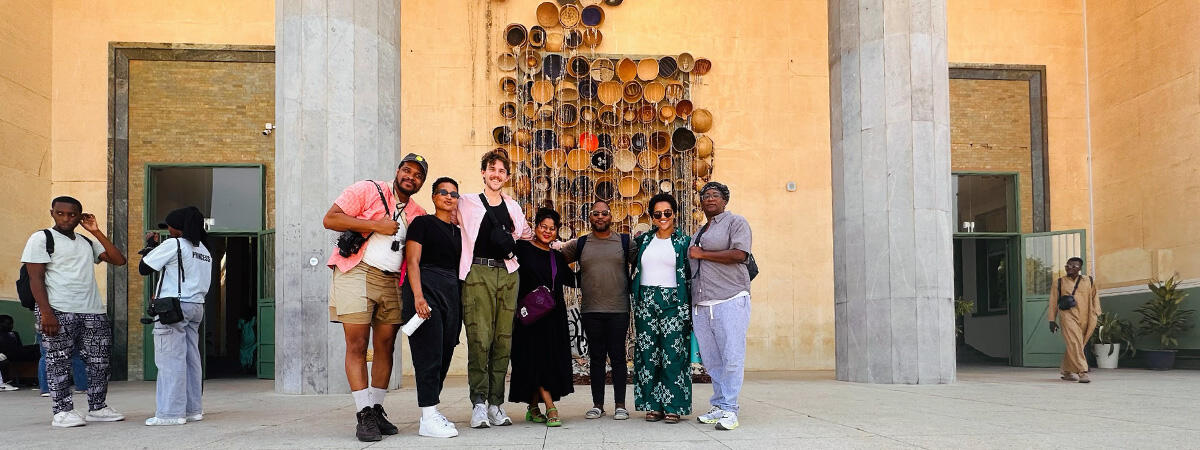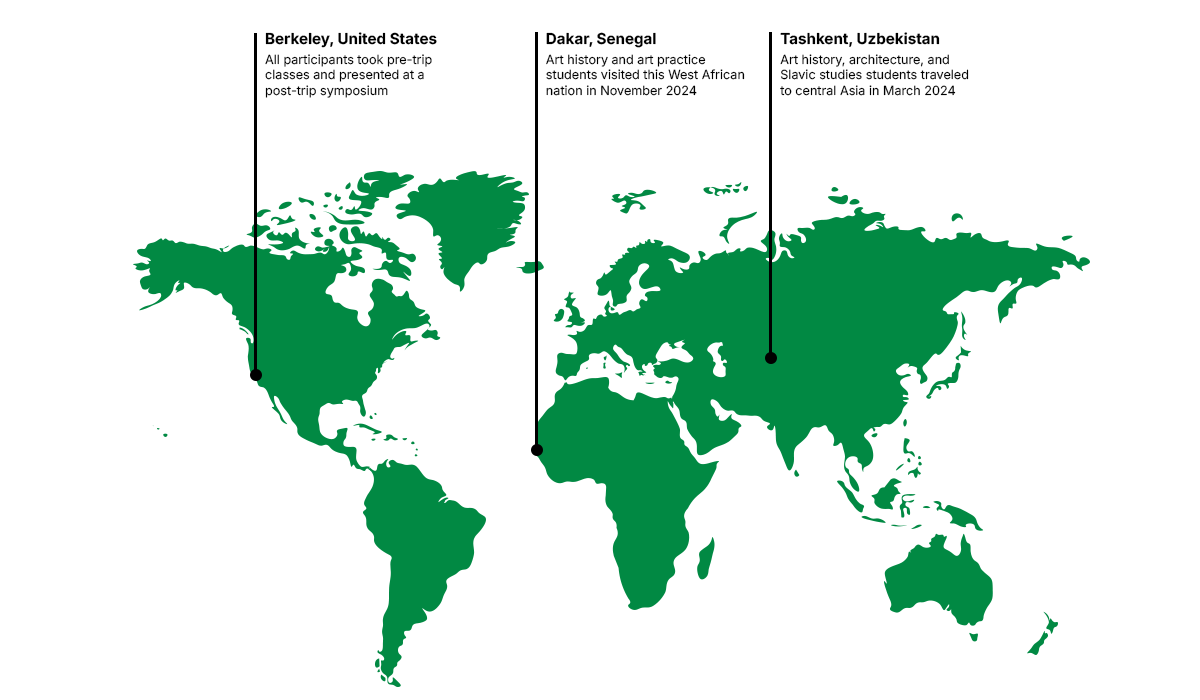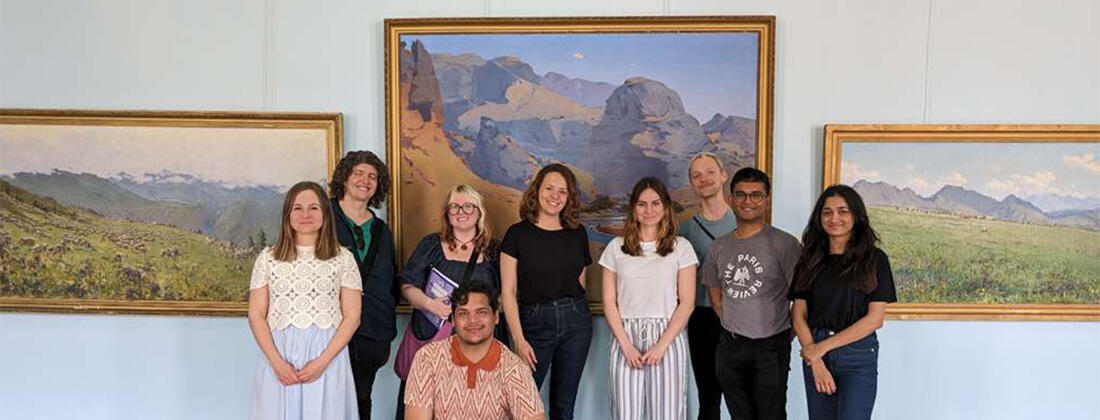UC Berkeley’s influence traverses the globe, and thanks to the Judith Stronach Travel Seminar, its creative scholars can as well.
This past November, art history professors Zamansele Nsele and Ivy Mills led a group of six graduate students to Senegal for an immersive, nine-day trip to the 2024 Dak'Art Biennale — a major art exhibition that showcases contemporary African art every other year.
Un/Worlding Contemporary African Art
The group landed mid-morning in a sunny and laid-back Dakar, the capital. They were warmly welcomed by curators at the RAW Material Company’s art center and given a talk on Dakar’s art ecosystem, accompanied by a guided exhibition tour.
The travel seminar examined Pan-African festivals in the mid-20th century and Négritude, an anti-colonial literary movement that focused on affirming Black culture and identity. Over several days, the group lost track of time at the Ancien Palais de Justice, a brutalist-style building built in 1957 as a colonial courthouse and repurposed in 1966 for a Négritude-inspired exhibition at the First World Festival of Black Arts. That influential event marked a pivotal moment in African art history, directly sparking debates about the definition of African modernism and contemporary African art. Under the same ceiling, the 2024 Biennale displayed artwork addressing urgent themes of mourning, extractivism, climate change, water as a vector of memory, and the legacies of social upheavals.
The students enjoyed events in the Biennale’s fringe program, taking a ferry to Gorée Island and spending an entire day at the Manufactures Sénégalaises des Arts Décoratifs tapestry center in Thiès.
The Stronach Travel Seminar is a biannual tradition in the Department of History of Art. Judith Lee Stronach was an art historian, poet, educator, journalist, human rights advocate, and patron of the arts. Stronach, the spouse of UC Berkeley professor Raymond Lifchez, was deeply embedded in the campus community. After she passed away in 2002, her estate and loved ones established several programs in her honor to commemorate her lifelong commitment to intellectual and creative growth.
Though the Department of History of Art organizes the Stronach Travel Seminar, students from related disciplines — even undergraduates — can apply to join. In Senegal, three attendees were pursuing their master’s in fine arts (MFA) degrees.

The Dakar trip afforded graduate students with plenty of time to view art and talk to the creators
Salimatu Amabebe is a Nigerian-American chef and multimedia artist who works with food, film, photography, sculptures, and installations. To Amabebe, attending the Biennale offered an unparalleled opportunity to engage with artists, curators, and thinkers throughout the African diaspora. Walking through the city’s exhibitions expanded his understanding of what an art festival can be: not solely a curated event, but “a living, breathing conversation rooted in place.”
“It felt especially important to experience this event alongside my classmates, professors, and members of my graduate school cohort,” said Amabebe, who graduated with a master’s in fine arts in December. “Being immersed in so much art during the day, and then processing those encounters in conversation with others who share a deep investment in the subject matter, felt both energizing and intellectually expansive.”
Amabebe’s experience is exactly what art history professors are hoping to engender. Though curators can record objects and upload them online, the experience cannot compare to viewing materials in person with other artists and scholars. For students interested in contemporary artistic movements from outside the West Coast, there is no substitute for visiting museums and galleries in the region and speaking with the artists themselves.
“Participating in the travel seminar to Senegal was a deeply meaningful experience,” said Amabebe. “The Biennial didn’t just enhance my research and practice — it reoriented it. This trip expanded my sense of what’s possible as an artist and thinker.”
Realism ≈ Modernism: Uzbekistan and Soviet Art
Senegal was the second art history trip in 2024 sponsored by the Stronach Travel Fund. In March, Berkeley scholars visited Uzbekistan. Guided by history of art professor Aglaya Glebova, students navigated a 24-hour door-to-door trip and a 12-hour time difference over their spring break.
Landing in the capital city of Tashkent at 4 a.m., the group began by exploring the city’s architecture. The following day, they visited the Decorative Arts Museum and spent several hours studying easel painting at the house-museum of Ural Tansykbaev, a key figure of Uzbek Soviet painting.
Largely rebuilt in the aftermath of a devastating 1966 earthquake, Tashkent was a model Soviet city, with architects and construction worker crews from all over the Soviet Union contributing to the project. Today, the urban landscape is a mix of seismic modernism from the 1960s and 1970s, national revivalist architecture, and the glass facades of the 1990s and 2000s.

The seminar aimed to examine 20th-century realism as a critical and innovative mode of art-making. The students also investigated the intersection of Uzbek art’s visual relationship to Soviet anti-colonial and imperial politics. Glebova aimed to honor the spirit of Judith Stronach not only by seeing rare works of art firsthand, but also by engaging with a wide variety of objects, images, and sites.
“Participating in Professor Glebova's seminar on 20th century art in Soviet Uzbekistan has been a highlight of my time at Berkeley,” said Tausif Noor, a Ph.D. student in history of art who works as a curatorial associate at BAMPFA. “As I work on my own research, I carry with me the lessons imparted from this trip: to think critically about global connections, question my own biases, and to always make time to share massive trays of plov with friends and mentors.”
The main destination was the I.V. Savitskii State Museum of the Arts in Nukus, an hour-and-a-half flight west from Tashkent. Founded in 1966, the museum has an extraordinary collection of Soviet paintings and sculptures, especially from the 1920s and 1930s. The group spent three days in the Savitsky museum, viewing and discussing works together, followed by student presentations on their chosen objects, from Nikolai Karakhan’s paintings to Damir Ruzybaev’s sculptures. They also made time to visit the ancient Mizdakhan necropolis, just six miles east of the border with Turkmenistan.

Soviet-era Uzbek artists were often inspired by the region's striking landscapes
The students then spent the weekend in Samarkand, visiting Registan Square, Gur-e-Amir (or Timur’s Mausoleum), the Fine Arts Museum, and the Afrasiab Museum. Returning to Tashkent, they were treated to a tour of a mahalla, or traditional neighborhood, by the nonconformist artist Vyacheslav Akhunov.
On May 6, the students presented their work in a department symposium, so that the ideas they brought home from Uzbekistan can continue to percolate across the campus community.
Frederik Braüner, a third-year Ph.D. student of architectural history, attended the travel seminar to Uzbekistan to compare aesthetic expressions with his focus on Nordic countries. Despite the regions’ geographical and political differences, Braüner found many overlapping aesthetic, material, and ideological traits.
“This comparative lens to the study of modernism has since become a core part of my dissertation,” said Braüner, “where I interrogate and compare expressions of modernism across Northern Europe, the North Atlantic, and the Arctic.”
Braüner says the course and research trip improved his ability to conduct visual, material, and formal analysis.
“Such skills are best cultivated through on-site analysis, where close looking and extended discussions help fine-tune our analytical awareness,” said Braüner. “When viewed in real life, the three-dimensionality of brush strokes, the material contrasts of mosaics and mortar, or the spatial monumentality of Soviet urban planning reveal themselves in a richer, more multifaceted way that cannot be fully captured in photographic reproductions.”
“As graduate students — especially for those of us studying regions very distant from the U.S. or conducting comparative studies across vast geographies — such opportunities to visit our cases are rare due to the financially difficult years of graduate school,” continued Braüner.
Many of UC Berkeley’s alums operate on the world stage, so it’s only fitting that they get some exposure to international perspectives while attending college. However, even though the academic benefits are clear, most college students can’t afford an international trip to enhance their studies. The Stronach Travel Fund fills this gap so that UC Berkeley can continue to serve as an international hub of creative scholarship.
The Department of History of Art is currently planning its next Stronach Travel Seminar, which will visit Venice in spring 2026.




